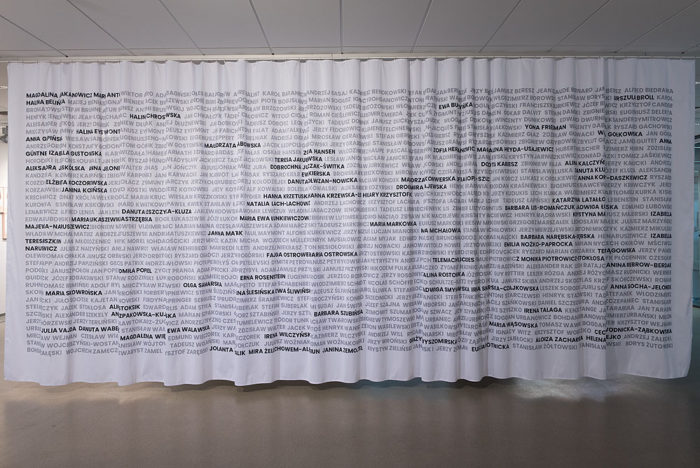Elżbieta Jabłońska
In statu nascendi, 2020

I push through a thicket of names first and last. Stopping at some for a while. Googling around. Searching out news, sometimes recent, more often not. Artists, art makers. An endless procession of events, attitudes, relationships. A document of the times, a symbol of changes, a soft historical tissue filled with memory. Over ten years, a total of 508 artists, including 430 men and 78 women, took part in the Golden Grape exhibitions, some of them more than once.
The title In statu nascendi (“in nascent state”) harks back to a 1977 exhibition that was part of the official show.
* * *
New Life_Boat Trip, 2017
In 2005, in a place near Bydgoszcz, I discovered a neon sign that said “New Life” [Nowe Życie]. It was mounted on a small building owned by the local Farming Cooperative, which was founded in the 1970s, when “new life” was meant as a brave new communist future. Although that world quickly proved to have been an illusion, its relics still exist, intriguing us and inspiring sentimental trips into the past. In 2009, the extremely suggestive sign was decommissioned and became mine. In the following months, the neon tubes were reconstructed, the electrical wiring replaced, and the sign brought back to life. With help from several galleries, I managed to “reanimate” New Life in order to then present it in various spaces, configurations, and contexts. Since then, the object has travelled from place to place as an artwork, initiating new events. It has been exhibited on numerous occasions at various institutions, in museums and galleries, and it has always marked them with its meaning, triggering off a process of change at those places or attesting to what already happened.
A white neon sign on an old, rusty frame serves as a symbol of a “reanimated” idea that sits well with various contexts. Working with it is also a continuation of practices related to the tracing of contents in the ordinary reality and transposing them to the field of art. A “new life” does not have to denote a revolution, an upheaval, does not have to entail an end. It can happen anywhere and anytime. What it is about is making oneself ready for change, opening up to the unknown, searching for new solutions for oneself, but also for places that are losing their significance.
One of the more important forms of presentation was a boat trip that took the neon sign from Nakło nad Notecią to Berlin aboard the Łokietek, a vessel of the Inland Navigation School in Nakło, for the exhibition COMMON AFFAIRS. Revisiting the Views Award — Contemporary Art from Poland, co-organized by the Zachęta National Gallery of Art, Deutsche Bank KunstHalle, and Polnisches Institut Berlin. The unique, six-day-long trip, in which I participated, was documented on video and in still image.
https://www.facebook.com/zycienowe/Elżbieta Jabłońska
Elżbieta Jabłońska, In statu nascendi, 2020, print on textile, 280 x 800 cm
Produced with the support of the City of Bydgoszcz
(list of names based on Chronology, in: Konrad Schiller, Awangarda na Dzikim Zachodzie. O wystawach i sympozjach Złotego Grona w Zielonej Górze, Warsaw: Stowarzyszenie 40 000 Malarzy, Zielona Góra: BWA, 2015)
Elżbieta Jabłońska, New Life_Boat Trip, 2017, film 45’48’’, 16 photographs, 30 × 40 cm each
Produced with the support of the City of Bydgoszcz
Elżbieta Jabłońska studied Fine Arts at the Mikołaj Kopernik University in Toruń. Since 1996, she has worked in the Department of Drawing there, teaching a course in Intermedia Drawing (now as professor). She has participated in numerous individual and group exhibitions. Her oeuvre includes long-term activities based on collaboration with cultural institutions and the public, community art projects, and curatorial endeavours. Exploring contemporary behavioural patterns, she plays ironically with ascribed social roles and the mechanisms of art institutions. Reflecting on artists’ social commitment, she analyzes semantic relationships and disquieting inadequacies between form and content in linguistic utterances (neon signs). Often discussed in feminist or post-feminist terms, her work includes installations, photographs, performances, and spatio-temporal practices. She considers the artwork as a relational object whose meaning and significance can be subject to change and negotiation. Recently she has focused on artistic gestures that encourage activism, community-building, dialogue and consensus.
“. . . In her work Jabłońska is preoccupied first and foremost with the modern individual’s schizophrenic split between numerous worlds in which they function simultaneously, and each of which demands their full involvement . . .” (Marek Krajewski, Distanced from the Role. On the Art of Elżbieta Jabłońska)